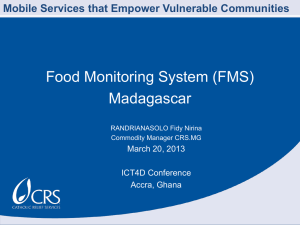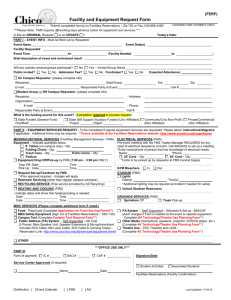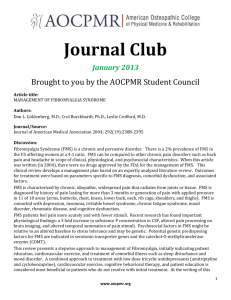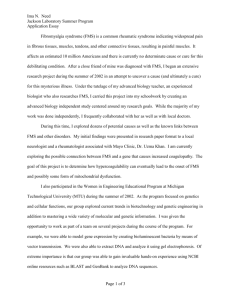Fibromyalgia: Neuropathic Or Not
advertisement
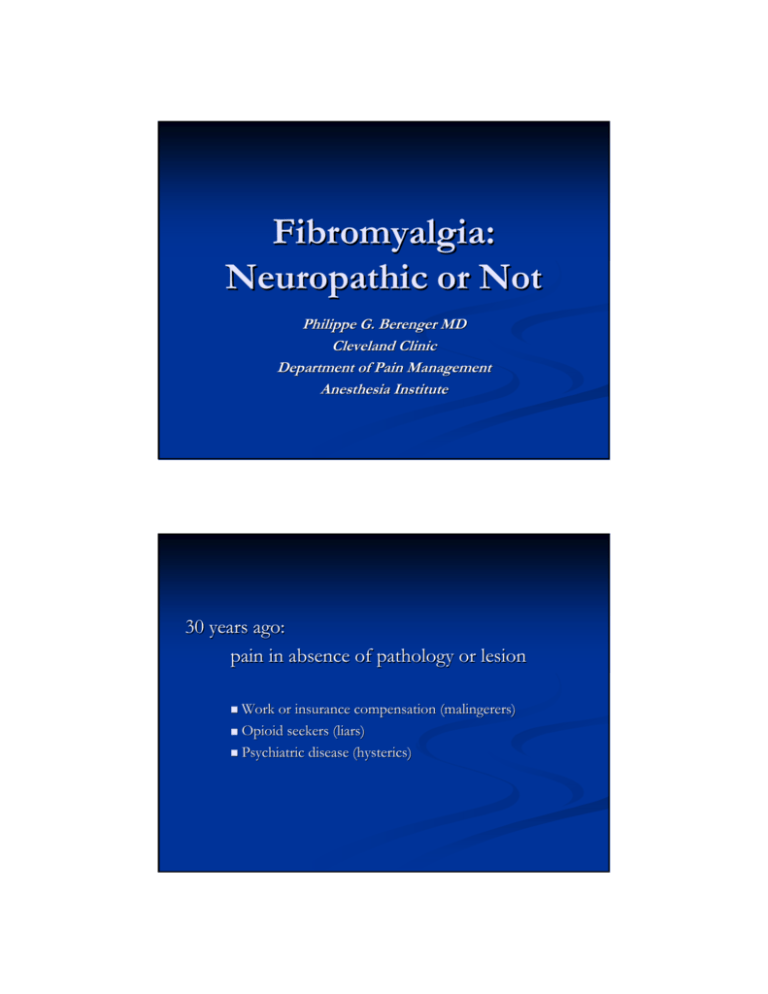
Fibromyalgia: Neuropathic or Not Philippe G. Berenger MD Cleveland Clinic Department of Pain Management Anesthesia Institute 30 years ago: pain in absence of pathology or lesion Work or insurance compensation (malingerers) Opioid seekers (liars) Psychiatric disease (hysterics) Always looking for the “pain generator” La Columna Rota • 1944 Mexican painter Frida Kahlo FMS NEW definitions NEW perceptions Mechanisms and pathways associated with FMS and central sensitization clearly exist FMS shares same pathways as many of the neuropathic pain syndromes ( IBS, Interstitial cystitis, CRPS) Variable Pain Mechanisms Nociceptive pain – generated by noxious stimuli Inflammatory pain – produced by tissue injury / immune cell activation Neuropathic pain – due to a lesion of the nervous system Pain with no clear etiological factor: Central sensitization Hereditary component in developing central sensitization in particular particular system patterns (fibromyalgia, Temporomandibular joint disease, tension headache, headache, irritable bowel) FMS….one or many ? Chronic Lyme disease Post- traumatic stress disorder Chronic fatigue syndrome Gulf war syndrome Multiple chemical sensitivity Commonly used Terms 1) Chronic Widespread Pain (CWP) 2)Fibromyalgia (FMS) > 3 months Lt & Rt side of body + axial skeleton 4 -15 % of population Defined by ACR in 1990 CWP + 11 of 18 TP’ TP’s 1 to 4 % of population Redefined by ACR in 2010 without TP’ TP’s 3)Myofascial Pain Syndrome (MPS) NO biological difference between any of the above + TP’s = Fibromyalgia ? Tender Points The gold standard? “ New” New” = NOT gold standard Signs and Symptoms Among Unselected FMS Patients 20 consecutive patients at initial visit ( )=% Sound Odor Light 12 (60) 13 (65) 13 (65) Poor sleep 20 (100) Low energy 20 (100) IBS 17 (85) Urinary FQ 17 (85) Orthostatic 17 (85) Wilke W. Clev Clin 2005 ACR (1990) Criteria Compared signs and symptoms of 293 FMS patients (Dx’d by “experts”) vs 265 control pain patients (OA, CTD). The symptom of widespread pain for at least three month’s duration and the presence of 11/18 tender points (4 KG) (initially examined 24) provided sensitivity of 88% and specificity of 81% for TPs. Wolfe et al: Arthritis Rheum: 1990 The Spectrum WSP Better WSP Alone Worse WSP +TPs WSP + TPs + Fatigue ACR (1990) wanted to simplify definition ACR= pain + TP (fatigue was not included) New Definition severity of pain severity of fatigue diffuse pain > 3 months Sleep difficulties Stress – anxiety /depression TP likely (but # irrelevant) “New” = Symptom Intensity Scale (ACR 2010) Developed by Wolfe and Rasker (2006): 25,417 patients with various rheumatic diseases – found that a “Symptom Intensity scale score” > 5.75 differentiated FMS from other rheumatic diseases – it identified 95 % of the FMS (from usual ACR definition) AND was predictive for general health among all rheumatic disease patients. Correlates with patient perceived pain, depression and disability. NOW part of a new ACR classification for FMS Questionnaire in 2 parts ( patient completes in 5 minutes): 1) Widespread PAIN index (WPI): number of painful anatomic areas (possible 19 areas) jaw, chest, abdomen, upper leg, lower leg, upper arm, forearm, upper back, lower back, shoulder, hip – patient response is YES or NO and indicating LEFT or RIGHT side Score will be between 0 and 19 2) Symptom SEVERITY scale ( SS score) : Fatigue Waking unrefreshed Cognitive symptoms Rate each of these over the past week: 0= no problem 1= slight or mild problems 2= moderate, considerable problems, often present and or at moderate moderate levels 3= severe, pervasive, continuous, life disturbing 2) Symptom Severity scale ( SS score) : Considering somatic symptoms in general indicate whether the patient patient has : 0= no symptoms 1= few symptoms 2= moderate number of symptoms 3= a great deal of symptoms The SS scale score is the sum of the severity of the: 3 symptoms(fatigue, waking, cognitive) + the extent / severity of somatic symptoms in general The final score is between 0 and 12 NEW Survey criteria for Fibromyalgia (ACR ) WPI pain scale >= 7 Symptom Severity (SS )Scale > = 5 OR WPI pain scale 3-6 Symptom Severity (SS) Scale > = 9 FMS – MIMICS, COMPLICATES other diseases Can occur with auto immune diseases ( RA, SLE, Sjogren’s) = fatigue, HA, joint stiffness out of proportion to other measures of autoimmune disease activity In FMS (vs. CTD): Diffuse pain at rest Poor sleep Joint pain without swelling HA and depression In the absence of other signs and symptoms Overlapping Conditions with Widespread Secondary Hyperalgesia Allodynia FMS: a clinical entity – not a disease Use FMS as a working hypothesis in which to group certain clinical features (sleep disturbance, diffuse pain, +- TP, anxiety-stress, IBS etc) Determine what symptoms are FMS related and which are related to structural or systemic pathology = avoid intervention or surgery on functional and neuropathic symptoms Case #1 40 yo female with history of rheumatoid arthritis. On disease modifying meds for her RA which is considered stable Chief complaint: pain in arms Right more than Left. Randomly occurring numbness in both hands mainly in D4 and D5. Symptoms worse as day progresses. Feels best in am. Midscapular and axial neck pain Hx of right carpal tunnel and right cubital tunnel release 1 year ago - transient benefit Clinical exam Painful cervical ROM – mainly in extension Negative foraminal compression for referred UE symptoms Tender over right lateral and medial epicondyle, midtrapezius and both greater trochanters Pain with shoulder abduction and internal rotation - but negative impingement signs and strong rotator cuff Normal DTR’s in upper – lower extremities Negative Hoffman’s, Babinski Normal vibration and temperature discrimination Symmetrically weak proximally and distally to resistive testing XR and Imaging Cervical spine showed disc space narrowing C4-5,C5-6, C6-7 with grade 1 listhesis at C4-5 and C5-6 Cervical MRI showed mild central canal stenosis at C5-6 and neural foraminal stenosis moderate at C5-6 and C6-7 EMG compatible with bilateral carpal tunnel syndrome Clinical course Cervical epidural steroid injection - no benefit Left carpal tunnel injection - no change in symptoms No response to nighttime bracing Physical therapy – “feels worse” Follow-up visits Difficulty falling asleep and nighttime awakening occasionally with pain Abdominal cramping periumbilical pain and constipation and occasional diarrhea. Negative upper GI, colonoscopy and abdominal CT other than gallbladder wall thickening Cramping in feet and restless leg feeling and during the day, feeling of “whole leg pain and weakness” unrelated to position or walking Options General surgery consult for lap cholecystectomy Orthopedics consult fro carpal tunnel and epicondylitis Spine surgery consult for spinal stenosis and radiculopathy Sleep medication Pain medication None of the above Multifactorial pathogenesis Pathogenesis genetics + environment Pathogenesis: genetics + environment 1) Borderline Neurobiological factors: General sensory augmentation Heat , Cold, Noise, Smells and other sensory stimuli Decreased activity of descending inhibitory pathways (deficit in serotonin, norepinephrine, dopamine) Hypothalamic- Pituitary axis dysfunction = decreased cortisol response Pathogenesis: genetics + environment 2) Excessive nociceptive firing & central sensitization Trauma Infection Sleep depravation cytokines (secondary to decreased cortisol response) peripheral nociceptors via NMDA Dorsal horn sensitization allodynia widespread pain Pathogenesis: Pain fear- avoidance stress exercise /sleep IL-6 cytokines Dysregulation monoamine pathways nociceptor sensitization Gate control dysfunction at dorsal horn Pathogenesis DEPRESSION / ANXIETY lead to: Disruption of short wave sleep (SWS) i.e. stage 3 and 4 of non-REM sleep = disruption of synthesis of hormones and neurotransmitters that govern many organ systems and the CNS. Decreased activity of pituary endorphins which modulate nerve excitability. Decreased Serotonin levels = increased nerve firing Pain Comorbidities: Sleep and Mood Alterations Pain Functional impairment Depression/ anxiety Sleep disturbances Fibromyalgia Syndrome how do we explain it ? FMS = Central Sensitization All nerves in FMS patients are more sensitive than they should be including the brain and spinal cord: Difficulty with concentration / focus Light, odors , sounds become intolerable IBS Interstitial cystitis Autonomic dysfunction = vasovagual symptoms Central sensitisation Central sensitization readily induced in animal and human volunteers after activating nociceptors (e(e-stim, mustard oil, capsaicin, heat or UV burn,hypertonic saline injection) in skin, viscera or muscle Sensitization phenomenon presents as: Tactile allodynia Hyperalgesia Enhanced pressure and thermal sensitivity Spreading to neighboring nonstimulated sites and remote regions Central Sensitization: objective findings reproduced in volunteers and animal models Nociceptors can become sensitized after injury reducing there firing firing threshold Low frequency action potentials (stimuli) into the CNS generate increased synaptic efficacy in nociceptive neurons in dorsal horn of spinal spinal cord which persisted after the stimuli had ended (LTP =long term potentiation) potentiation) This state of sensitization amplified subsequent responses to other other non nociceptor fibers (ie. A beta fibers mediating allodynia) Gain (is a measure of the ability of a circuit - often an amplifieramplifier- to increase the power or amplitude of a signal from the input to the output)of neurons in the pain pathway is increased thus non noxious stimuli can activate activate the pain pathway and pain is felt in the absence of a real noxious stimulus stimulus Consequences of central sensitization can be measured by objective objective biomarkers (ie. Functional MRI changes in the cortex) Centrally acting drugs may reduce central sensitization : Ketamine Ketamine (NMDA antagonist), gabapentin reduces tactile allodynia, duloxetine, milnacipran, milnacipran, lamotrigene and Cox 2 inhibitors (if sensitization is triggered by peripheral inflammation) Physiology of Pain Perception Transduction Transmission Modulation Perception Interpretation Behavior Peripheral Nerve Limbic Forebrain System Injury Descending Pathways Dorsal Root Ganglion Ascending Pathways C-fiber α- Fiber α- Fiber Brain Dorsal Horn Spinal Cord Central sensitization Increased excitability of spinal cord neurons (dorsal column) from peripherally sensitized afferents Leads to increased duration (spontaneous firing) and enlarging area of response (wide dynamic range neurons and “wind up”) Leads to abnormal neuro - anatomical reorganization with connections between A beta, A delta and C fibers (sprouting) - which can spread thus involving multiple dermatomes = diffuse symptoms = symptoms outlast the injurious stimuli (LTP=long term potentiation) Normal Pain Pathways in the Dorsal Horn Stimulus Innocuous Noxious Noxious Sensory information Withdrawal reflex Pain Mannion et al. Clin J Pain. 2000;16(suppl 3):S1443):S144-S156. Dorsal columns FMS….What doesn’t Work TP injections Flexibility exercises Chiropractic Modalities (US, massage) Acupuncture Opioids Corticosteroids NSAI Benzodiazepines Melatonin Calcitonin Thyroid suppl Magnesium Transcranial Direct Current Stimulation (tDCS) Transcranial Magnetic Stimulation (TMS) Fregni et al. A randomized, sham controlled study of transcranial transcranial direct current stimulation in the treatment of pain in fibromyalgia. Arthritis Rheum. 2006;54:39882006;54:3988-3998 Passard et al Effects of unilateral repetitive transcranial magnetic magnetic stimulation of the motor cortex on chronic widespread pain in fibromyalgia. Brain2007;130(Pt 10):266110):2661-70 Analgesic Drugs Mechanism of Action Acetaminophen Decreases pain and possibly fever Nonselective NSAIDs Inhibition of COXCOX-1 and COXCOX-2 isoenzymes isoenzymes inhibits prostaglandin synthesis COXCOX-2 selective inhibitors Selective for COXCOX-2 inhibition (COX(COX-1 sparing) Tramadol/Tapendalol Mixed actions: opioid agonist plus norepinephrine/serotonin reuptake inhibitor Opioids Bind to opioid receptors, producing agonist action that inhibits pain impulses Antidepressants Inhibit norepinephrine/serotonin reuptake, H1 receptors, NMDA receptors, peripheral sodium channels2 Anticonvulsants Sodium and calcium channels2,3 Tramadol Weak μ opioid agonists norepinephrine and serotonin reuptake inhibition ER= Lag in drug absorption; reaches peak in 12 to 15 hours; steady state in 4 days An adequate trial requires 4 wk at maximum dosage Initiate tramadol ER at 100 mg/d and increase every 5 days to maximum of 300 mg/d Harati et al. Neurology. Neurology. 1998;50:18421998;50:1842-1846. Tapendalol Mu opioid agonist, serotonin /NE reuptake inhibition Adjustment for renal insufficiency Available in IR (50, 75, 100 mg) titrate up to Available in ER (50,100,150,200 mg) titrate up to Side effect and precautions as with all opioids, possible serotonin syndrome in combination with other serotonin reuptake inhibitors (duloxetine, TCA’s etc) Gabapentin and Pregabalin: Mechanism of Action Binds to a subunit of voltage-gated calcium channels Reduces Ca2+ influx during depolarization Analgesic, anxiolytic, and anticonvulsant activity Reduces release of excitatory neurotransmitters, ( glutamate, norepinephrine, substance P) Effective in trials of epilepsy, neuropathic pain, and generalized anxiety Onset and Resolution of Dizziness and Somnolence in Controlled Trials of Pregabalin in FM Dizziness Somnolence Incidence* 38% 20% Discontinuation* % (n) 6 (85) 3 (52) Median time to onset 2 days 3 days Median time to resolution (completers) 17 days 34 days • Among those patients who reported dizziness or somnolence 38% and 58%, respectively continued to experience the reported adverse event for the duration of the trial *All pregabalin dose groups pooled (n=1,517) Assessment of safety and tolerability was based on the 3 fixed-dose trials in FM. Data on file. Pfizer Inc, New York, NY. TCAs: Mechanisms Relief of pain through serotonin and norepinephrine reuptake blockade1 Blockade of -adrenergic receptors2 Sodium and potassium channel modulation1,2 Modulation of monoamine neurotransmitters1 ? NMDA-receptor antagonism1 1. Lawson. Expert Opin Investig Drugs. Drugs. 2002;11:14372002;11:1437-1445; 2. Sindrup et al. Pain. Pain. 1999;83: 389389-400. TCAs: Adverse Effects Commonly reported AEs (generally anticholinergic) Fewest AEs Blurred vision Cognitive changes Constipation Dry mouth Orthostatic hypotension Sedation Most Sexual dysfunction AEs Tachycardia Urinary retention Desipramine Nortriptyline Imipramine Doxepin Amitriptyline (Pamelor) (tofranil) (sinequan,Sinelor) (Elavil) SNRIs Venlafaxine(effexor) and duloxetine(cymbalta) Inhibit norepinephrine and serotonin reuptake and increase synaptic availability Results suggest safety, tolerability, and effectiveness in patients patients with painful DPN Minimal anticholinergic Aes Milnacipran (savella) FDA approved in 1/2009 for FMS (used since 1998 in Europe for depression) Effexor (venlafaxine hydrochloride) [package insert]. Philadelphia, Pa: Wyeth Pharmaceuticals; 2004; Sindrup et al. Neurology. 2003;60:12842003;60:1284-1289; Wernicke et al. Poster presented at: 56th Annual Meeting of of the American Academy of Neurology; April 2424-May 1, 2004; San Francisco, Calif; Raskin et al. Poster presented presented at: 23rd Annual Meeting of the American Pain Society; May 66-9, 2004; Vancouver, British Columbia, Canada; Wernicke et al. Poster Poster presented at: 23rd Annual Meeting of the American Pain Society; May 66-9, 2004; Vancouver, British Columbia, Canada. Sodium Oxybate (Xyrem) Sodium salt of -hydroxybutyrate (GHB), an endogenous neurotransmitter and/or neuromodulator and metabolite of GABA1 Approved for treatment of narcolepsy symptoms (EU, US, Canada) 2 Schedule # 3 drug (potential for abuse) Approved in some EU countries as an IV anesthetic and for treatment of alcohol withdrawal Increases slowslow-wavewave-sleep and reduces sleep disruption 1 RCT, double blinded, placebo controlled showed improved function function and pain Russell et al, Arthritis and Rheum,2009; 60(1)29960(1)299-309 Study Design - Sodium Oxybate for Fibromyalgia Design: Randomized, double-blind, placebocontrolled, parallel-group design at 108 sites US and EU (n=573) Treatment Groups: Sodium oxybate 4.5 g/night (SXB4.5g) Sodium oxybate 6 g/night (SXB6g) Placebo (PBO) Data on file, Jazz Pharmaceuticals, Inc. FIQ & PGIC Responders – Week 14 FIQ Data on file, Jazz Pharmaceuticals, Inc. PGIC Pain VAS Responders at Week 14 PBO (n=183) SXB 4.5 g (n=193) SXB 6 g (n=183) Data on file, Jazz Pharmaceuticals, Inc. Other options – non FDA approved • Dopamine agonist = Mirapex (pramipexole) 4.5 g @ bedtime Holman et al – Randomized ,double blind, placebo controlled trial of pamipexole, pamipexole, a dopamine agonist , in the treatment of patients with fibromyalgia receiving receiving concomitant medications. Arthritis and Rheum. 2005;52:24952005;52:2495-2505 • Zanaflex (tizanadine) 4 mg at bedtime Russell IJ et al. (2002) Therapy with a central alpha 22-adrenergic agonist (tizanidine) decreases cerebrospinal fluid substance P, and may reduce serum hyaluronic acid as it improves the clinical symptoms of the fibromyalgia syndrome. Arthritis Rheum 46: S614 EULAR treatment recommendations (2008) (European League of Associations for Rheumatology) Multi disciplinary approach (pharmacological and behavorial) Heated pool treatment with or without exercise Individually tailored exercise (aerobic & strength training) Relaxation, physiotherapy, psychological support on case by case basis Tramadol / Tapendalol for the management of pain (no opioids or corticosteroids) Antidepressants (they noted only ONE trial lasting longer than 12 weeks and did not show improvement in pain compared to control) Pregabalin can reduce pain - should be considered (functional improvement not assessed in studies) Recommendations based on FMS (ACR criteria only) litterature review review and expert review (19 experts from 11 countries) Ann Rheum Dis 2008: 67: 536536-541 Summary Treatment Do not treat the symptoms of FMS Treat the pathogenic factors (depression, sleep disorders, distress) CNS serotonin and norepinephrine reuptake inhibitors TCA Pregabalin Aerobic exercise Non pharmacological = meditation, biofeedback, aquatics, massage Treat “syndromes within the syndrome”: IBS Restless legs Irritable bladder Underlying triggers (focal areas of OA, nerve compression etc) Practical considerations Symptoms are important mediators of disability FMS patients frequently minimize psychological distress and describe HIGH levels of disability Repeated reassurance is frequently met by challenges to the physician’ physician’s judgment and competence Patient = symptoms are ominous Physician = symptoms have no basis in disease Mismatched outlooks Physician frustration Patient dissatisfaction How can we best share the FMS diagnosis with our patients ? Practical considerations “ You have a pain problem that is relatively common. It’ It’s not harmful but it is very difficult to deal with. We don’ don’t really understand it well. We know there are things we can do that will help but it’ it’s unlikely that the symptoms will resolve or disappear. Some physicians refer to the combination of these symptoms as fibromyalgia but there is no known cause” cause”. When fibromyalgia is present it changes the features of other diseases Understand the potential consequences of labeling a patient with FMS diagnosis – implications for work , SSD, litigation in accidents or post traumatic allegations. Recognition of depression will improve overall health (use of Wolfe’ Wolfe’s ACR / Symptom intensity scale). Avoid frustration……. If all else fails ….. GO FISHING !!! (Colorado cutthroat trout) Thank you
